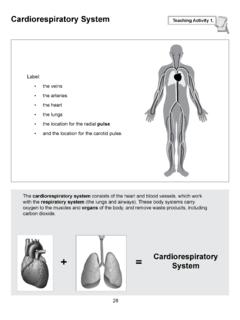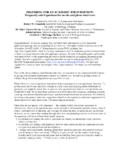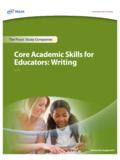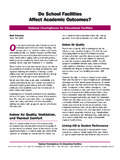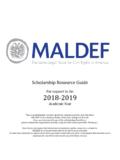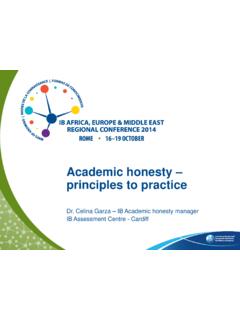Transcription of A Quick Toolkit for Enhancing Academic - …
1 1 What is Academic Language? A Quick Toolkit for Enhancing Academic Language in Physical Education Academic Language? Phoebe Constantinou & Deborah A. Wuest, Ithaca College 2 The purpose of this Toolkit is to define what Academic language in physical education is, why it s important, and how it can be implemented. The Toolkit provides clarifications and examples of language components such as the discipline-specific vocabulary, language function, syntax and discourse. A sequential example of how an Academic language objective would look in a physical education learning segment, how the teacher can promote this Academic language objective and how it can be assessed is provided. Moreover, we propose strategies, tools and tips that can enhance the development of all language components for Academic language proficiency. Purpose 3 Topic Page What is Academic Language?
2 4 Why is Academic Language Important? 5 Language Components 6 It s More Than Just Vocabulary 7 Vocabulary 8 Language Function 9 Syntax and Discourse 10 Academic Language Objective and Implementation 11 Connecting the Steps 12 Tools and Opportunities for Promoting Academic Language 13 Venn Diagram 14 Word Quilt 15 Strategies - Elementary Level 16 Strategies - Middle and Secondary Levels 17 Tips for Promoting Academic Language 18 Final Thoughts 19 References and Resources 20 Table of Contents 4 What is Academic Language? Academic language is defined as the language of academia. It differs significantly from informal spoken language used outside the classroom, as it is more formal, complex and sophisticated. Each discipline has its own specialized vocabulary and language function. Syntax, discourse and other general Academic vocabulary that cuts across all disciplines are also important parts of Academic language.
3 Students must acquire sufficient knowledge of general Academic language to decipher the meanings of a word and how it is used in various settings and disciplines. For example, the word "court" has a different meaning when used in a physical education context than when used in the discipline of law. Similarly, the word "flexibility" has a different meaning when it is used in physical education rather than in a business setting. 5 Why is Academic Language Important? Academic language is pivotal for Academic and professional success. It is used in writing, testing, classroom instruction and associated professional settings. It is the means of communicating complex concepts and conveying knowledge in each particular discipline. 6 Vocabulary Specialized words associated with the discipline Language Function Contrast, describe, signal, evaluate, sequence, etc.
4 Syntax Sentence structure (compound, complex), sentence length, transitions, verb tenses, active vs passive voice, etc. Discourse Speaking and Writing - instructing, describing, explaining, questioning, analyzing, evaluating, speculating, hypothesizing, socializing, etc. Language Components Vocabulary, Language Function, Syntax, and Discourse are the components of Academic language. All four components must be equally developed and individually addressed. Each language component is defined below 7 It s More Than Just Vocabulary Vocabulary Motor Skill Sport & Games Body Symbols Lesson plans Activity diagrams Games strategy diagrams Key Phrases V-cut Player-to- player defense Zone-defense Pass and move Indirect free kick Throw-in Offside Signals Discipline-specific language includes more than just vocabulary.
5 It includes symbols, key phrases, and signals used in the discipline to construct and communicate knowledge within the discipline. Here is how it applies in physical education. 8 Motor Skills: Gallop, skip, jump, slide, hop, catch, throw, etc. Movement Concepts: space awareness, personal space, etc. Perceptual-Motor Skills: Eye-hand coordination, eye-foot cordination, etc. Motor Skills Volleyball: overhead pass, underhand pass, serve, spike, etc. Basketball: lay-up, chest pass, bounce pass, free throw, player-to-player defense, zone defense, etc. Soccer: goalie, center, defense, offensive player, striker, long pass, short pass, dribble, corner kick, offside ,etc. Sport & Games Health-related Fitness: Flexibility, muscular strength and endurance, body composition Skill-related Fitness: agility, power, reaction time Exercise terms: anaerobic exercise, aerobic exercise, flex, fit, stretch, reps, set, etc.
6 Fitness & Conditioning Bones: scapula, clavical,sternum, radius , ulna, etc. Muscles: biceps, brachialis, brachilradialis, deltoid, etc Tendon: Achilles tendon, etc. Joints: elbow joint, wrist joint, hip joints, knee joints ,etc. Body Vocabulary This is a discipline specific vocabulary for physical education. This is not a complete list but rather some examples. 9 Language Function Language function is the component of the language that renders the purpose of using the language. For example, language is used in physical education for the purpose of describing a game strategy or interpreting a referee signal. The cue words listed underneath each language function (Describe, Analyze, Interpret, Contrast, Sequence, and Signal) can be used to further guide understanding of the specific language function. - Describe In other words That is to say According to Specifically What Who Why How Analyze Dissect Investigate Determine Scrutinize Examine Break down Interpret Estimate Believe Due to Since In light of Conclude that Guess Speculate Contrast On the other hand Despite Nevertheless Rather Still On the contrary Likewise However Contrary to Sequence Simultaneously Subsequently At which point At this time Signal 10 Syntax focuses on the technical part of the language, including grammar, punctuation, verb tenses, use of the passive or active voice, and transition words.
7 Discourse involves the mode of communication, whether it is verbal or nonverbal, oral or written. Vocabulary Function Syntax Discourse Syntax & Discourse All of these language components must come together seamlessly 11 Academic Language Objective and Its Implementation Speciialized Vocabulary: Skip, hop, run, level, etc. Language function: Contrast Syntax: Correct grammar & complete sentences Discourse: Written Language Components Students will be able to correctly formulate movement sentences showing their understanding of contrasts between low, medium, and high levels as they move using a variety of movement skills (hop, skip) called out by the teacher. Langauge Objective As students move around at different levels, stop and ask studens to orally and in full sentences contrast their level with someone else. Example: I am moving at a medium level but Petros is moving at a low level.
8 Teacher Actions Exit slip Quiz Questions Student demonstration Assessment Exit slip An elephant moves at a _____ level, but a/an _____ moves at _____ level. A turtle moves _____. However, a/an _____ moves _____. Identifying Language Components to be addressed provides a framework for developing the Language Objective, the Teacher Actions and the Assessment part of the learning segment. Using some of the cue words for contrasting, such as but and however, helps students understand the function of the language and exposes them to complete and more complex sentences. 12 \ Assessment Written Exit Slip An elephant moves at a _____ level, but a/an _____ moves at a _____ level. A turtle moves _____. However, a/an _____ moves _____. Connecting the Steps Language Components Language function: Contrast (Cue words: but, however) Syntax: Correct grammar & complete Sentences Discourse: Written exit slip Specialized vocabulary: skip, hop, run, level, etc.
9 Students will be able to correctly formulate movement sentences showing their understanding of contrasts between low, medium, and high levels as they move using a variety of movement skills (skip, hop) called out by the teacher. This shows how the language components are reflected in the objective and tied into the assessment. 13 Tools Graphic organizers Venn diagram Word quilt Word walls Bulletin boards Assessment Exit slips Test Quizzes Write/discuss activity/game strategies Homework Research projects Reflective journals Compare and contrast activities/sports End of class Discussion Summaries Tools and Opportunities for Promoting Academic Language Graphic organizers and other tools can greatly assist the teacher in incorporating Academic language into physical education. Other opportunities can be presented during homework, end of the class period, and during assessment time.
10 Examples of various tools are presented on the next few pages. 14 Court is smaller Birdie Racket handle longer Loses a stroke, service passes to opponent Wrist action snap Etc. Court is larger Ball Racket head larger Loses a stroke, opponent receives a point Wrist action firm Etc. Here is an example of a graphic organizer that can be used to help students understand the purpose of language function when contrasting. Other types of graphic organizers might be more appropriate for the purpose of sequencing or describing. Venn Diagram Tool Tennis Badminton Commonalities Played indoors and outdoors An object is hit Begins with service Serves diagonally Etc. 15 List the vocabulary being taught Translate the vocabulary into a different language Define using a picture or in writing Use the word in a sentence Pass (Greek) To move the ball/object from one person to another Petros passed me the ball and I was able to score.
